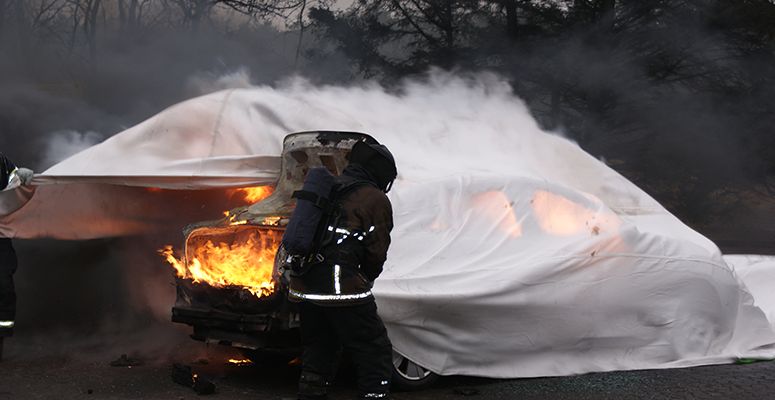Containing Electric Car Fires – A New Challenge for Fire Fighters

Containing Electric Car Fires – In the realm of firefighting, the tried-and-tested weapon against flames has always been water. Water is usually the most effective way of fighting fire because it deprives flames of oxygen. However, the lithium-ion batteries in Electric vehicles make it a bit more difficult to extinguish a fire with just water. Different methods need to be used for these extreme fires that reignite themselves. This presents a new challenge for firefighters all over the world.
The urgency to efficiently contain and extinguish fires in EVs has become a pressing concern worldwide. Understanding why these fires are rare but particularly challenging and exploring innovative solutions, has been our main focus at Fire Isolator. In this article, we will tell you more about why water falls short when containing Electric Car Fires. We will also tell you what methods we would recommend and why.
Why water falls short when containing Electric Car Fires
The rise of Electric Vehicles (EVs), and therefore the increase of Electric vehicle fires worldwide, has shown us that using just water is simply not enough to put out a fire in a lithium-ion battery. Lithium batteries are a type of rechargeable battery that uses lithium as one of the main components in its electrodes. They’ve become incredibly popular due to their high energy density, making them lightweight and capable of storing a significant amount of energy compared to other types of batteries. However, they also come with some major risks.
When it comes to electric vehicles, problems can occur when there is a malfunction in the lithium-ion battery. In this case, heat often builds up inside the battery (causing Thermal Runaway) and causes a chain reaction. As a result of this, there will be a fire or even an explosion. Even though the risk of an EV fire seems small, an electric car fire is very dangerous. An EV burns differently and more severely than a conventional car and is therefore far more difficult to extinguish.

How to Contain EV Fires
Because controlling an EV car fire is significantly different than putting out a normal car fire, we created the EV Car fire blanket. This fire blanket is the perfect method to isolate smoke and fire. Furthermore, our high-temperature resistant EV car Fire Blanket provides control of the situation and makes sure that collateral damage is minimal when deployed quickly enough.
Some Features & Benefits of the EV Fire Blanket:
- Up to 1600 degrees C°
- Reusable up to 6-7 times
- Can also be used for normal cars
- The blanket can be ordered in any size, and can also be used for LEVs.
- Tested according to ISO EN 13501-1
- Best Fire blanket for EVs based on several tests by our dealers
Of course, the Fire blanket is not a stand-alone solution. Although it is our most successful and best-sold product, we recommend using the full-fire isolator Concept for the best results.
Containing Electric Car Fires with The Fire Isolator Concept
At Fire Isolator, we offer our dealers training on how to use the Fire Isolator Concept. This training gives you the guidelines you need to successfully deploy our Fire Blanket over a burning (electric) car. The training also gives you more information about our other products:
- The aerosol units interrupt the chemical chain reactions occurring in the flames and suppress the fire resulting in further temperature reduction.
- The water mist lance for direct insertion into the battery of the EV car, to spray water over the blanket in order to reduce toxic fumes and smoke and to keep the car cool.
In advance, a thermal imager would be advised to measure the temperatures of the fire. If you can submerge the car into a dipping container with water after, we would also recommend you to do so.
Curious about the full Fire Isolator concept on video? You can find it on our video page.

